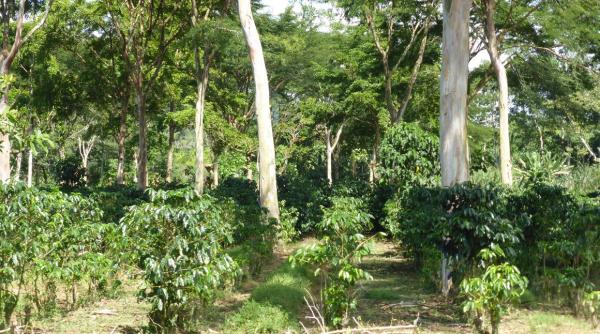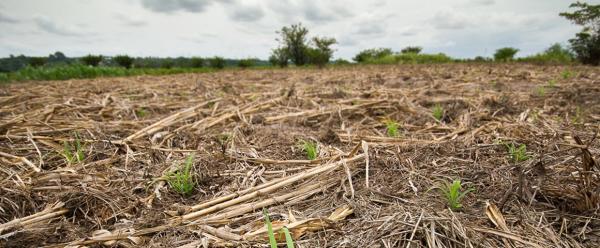Call to action 16 April 2025
- Home
- Press area
- Press releases
- Pesticides: global consumption is increasing
Pesticides: global consumption is increasing despite 60 years of integrated crop protection
.jpg)
In Reunion Island, pesticides have been almost entirely phased out in agroecological mango orchards, where biodiversity has increased: almost 800 species of arthropods and more than 100 herbaceous plants have been identified. Here, the ladybird Rodolia chermesina is eating a scale insect, Icerya seychellarum , which is a pest of mango trees© A. Franck, CIRAD
“Good intentions, hard realities”: the findings of the study published last month in Agronomy for Sustainable Development are difficult to accept, given just how prominent the concept of IPM has been over the last 60 years in the field of crop protection. The global consumption of pesticides continues unabated and the rare cases of reductions remain limited and localised. According to FAO, global pesticide use almost doubled between 1990 and 2018, increasing from 1.7 to 2.7 million tonnes*. The gap between “theory” and “practice” continues to grow, which the authors of the article believe is partly due to the uncertainty surrounding the concept of IPM.
“There are a hundred different definitions of IPM. Everyone has their own approach to the concept”, says Jean-Philippe Deguine, an agroecologist and entomologist at CIRAD and lead author of the study. “This uncertainty has produced different interpretations, generating confusion in the field and sometimes resulting in the implementation of contradictory strategies”.
The study criticises the failure to mobilise ecological processes frequently observed in existing IPM measures. Faced with a concept that they believe is now outmoded, the scientists call for agroecological crop protection that would revolutionise methods and knowledge, while addressing the current and future challenges for agriculture, in both the North and the South.
Integration or juxtaposition of techniques?
In theory, integrated protection fosters the harmonious integration of different techniques to control pest populations, and pesticides should be used sparingly. But in practice, pesticides are still prevalent. By way of example, in France, in 78 % of cases where the use of neonicotinoids is authorised, there is at least one non-chemical alternative, if not more, that could be used.
“Most farmers are ‘risk averse’ and use short-term economic arguments to justify chemical treatments”, says Françoise Lescourret, Director of Research in Agroecology at INRAE, Avignon, and co-author of the study. “They often consider that using pesticides will protect them from the risk of yield losses, whereas, in the long term, this use can cause many problems for crops and the environment”.
As long as the basis of crop protection is chemical, what role and impact can other methods of control have, such as biological control? Integration of the different control methods is rarely optimal, according to Jean-Philippe Deguine: “In most cases, we see the overlapping of several protection techniques, rather than any real coherent, organised and compatible integration. This means that farmers often use different techniques in succession, first chemical, then possibly cultural and biological, etc. These sequences are often incompatible or inconsistent. Chemical control impacts not only crop pests, but also the beneficial insects that can regulate them”.
Agroecological crop protection: giving ecological principles a central role
Many agro-ecosystems have been seriously undermined by the use of pesticides, and are losing momentum in terms of productivity, with substantial loss of biodiversity. To restore ecosystem health and to protect global health, there is an urgent need to put the principles of ecology back at the heart of crop protection.
Applying the principles of agroecology to crop protection essentially means improving soil health and developing biodiversity in and around cultivated land (hedges, “semi-natural” zones and other agroecological infrastructures), in order to encourage the presence of beneficial insects, in other words the natural enemies of crop pests.
For around 10 years, CIRAD has been testing agroecological protection in different fruit and vegetable cropping systems. In Reunion Island, for example, the method has proven effective in mango orchards. In a total of 13 mango orchards studied for three successive years:
- The use of pesticides has been considerably reduced, and in some cases almost entirely phased out**.
- The costs of protection have been more than halved.
- The workload has been reduced by almost 30 %.
- Biodiversity in and around fields has increased considerably (more than 800 species of arthropods and more than 100 different herbaceous plants have been identified in agroecological orchards).
- Production, in terms of fruit quantities, has not declined significantly.
The experiment has also been a success, on a larger scale, for banana plantations in the French West Indies. CIRAD, with its professional partners, has shown the effectiveness of cover plants in reducing pesticide use, which has been more than halved by the sector.
Numerous experiments are also being conducted in mainland France. For INRAE, the two experimental platforms, Dijon-Epoisses for field crops and Gotheron for orchards, put planned biodiversity – landscape infrastructures, companion plants, cover plants, plant associations in space and/or time – at the heart of pesticide-free systems.
“Of course, beyond these examples, there is still a lot to do in terms of research to develop effective agroecological protection that can be used for the great variety of crops”, say the researchers. Some crops are heavily impacted by a wide range of pests, and other species are very sensitive to pathogens that can be highly destructive. “This requires substantial investment in research to further develop agroecological solutions”.
The goal of agroecological crop protection is to end the use of pesticides in the medium term. To achieve this, the scientists recommend:
- Applying an organised protection strategy in the field, based on the principles of ecology and focusing on the prevention of pest attacks;
- Only considering chemical treatments as a last resort and using products that do not harm biodiversity (bees and other pollinators, microorganisms and soil fauna, etc.);
- Investing more in training on preventive agronomic and agroecological techniques and the prevention of plant health risks;
- Encouraging participatory approaches with farmers to develop solutions that are adapted to different terrains and will therefore be more readily adopted.
But also, and above all, developing policies that provide more effective incentives to reduce the use of pesticides and to support the agroecological transition.
* Source: FAO (2020)
For France, between the periods 2009-2011 and 2017-2019, the quantity of active substances contained in plant protection products sold increased by around 11 %, while the utilised agricultural area diminished by 0.6 %.
Source: Ministère de la Transition Agroécologique (2019)
**The treatment frequency index decreased from 22.4 to 0.3, in other words the use of chemical products was close to zero.
Reference
Jean-Philippe Deguine, Jean-Noël Aubertot, Rica Joy Flor, Françoise Lescourret, Kris A.G. Wyckhuys, Alain Ratnadass. 2021. Integrated pest management: good intentions, hard realities. A review. Agronomy for Sustainable Development, 41:38



























